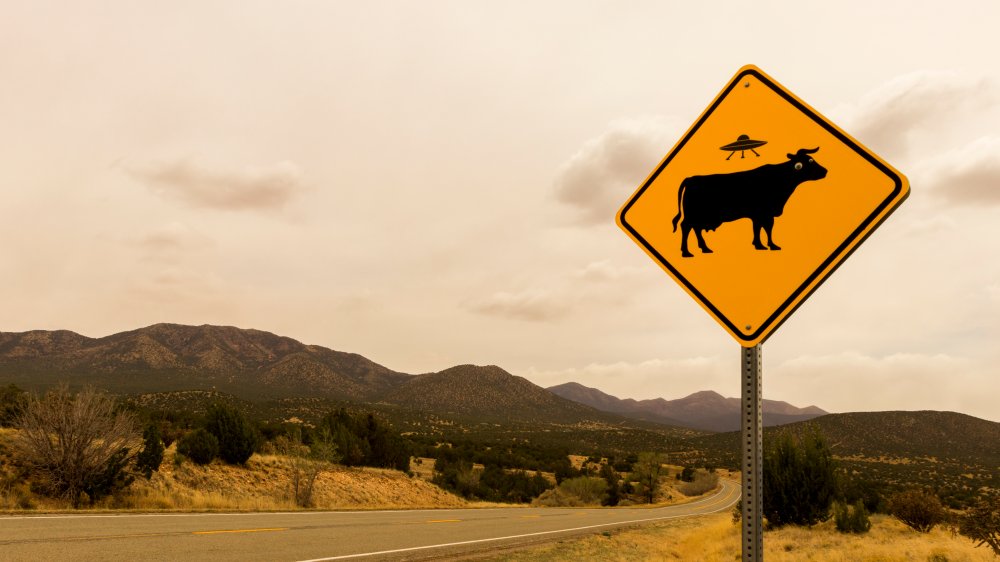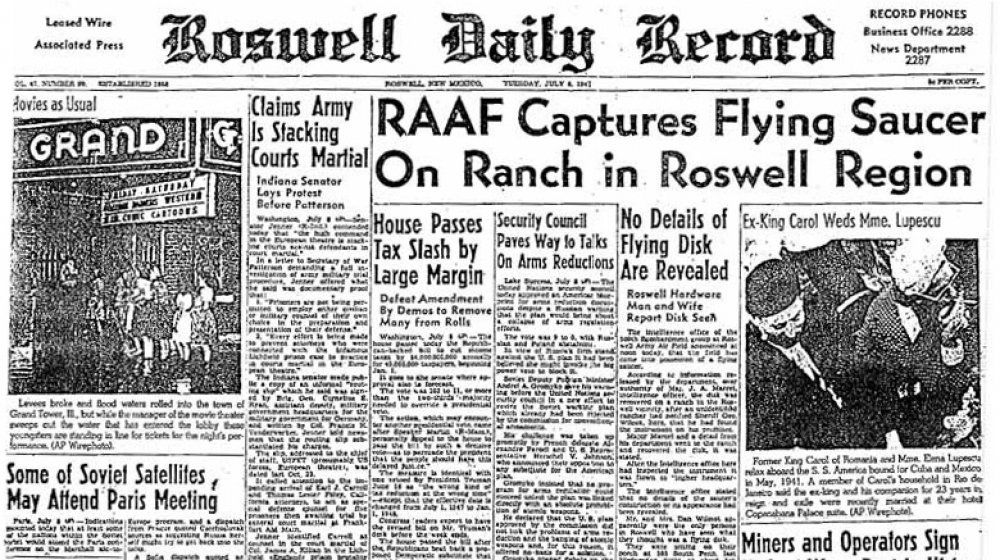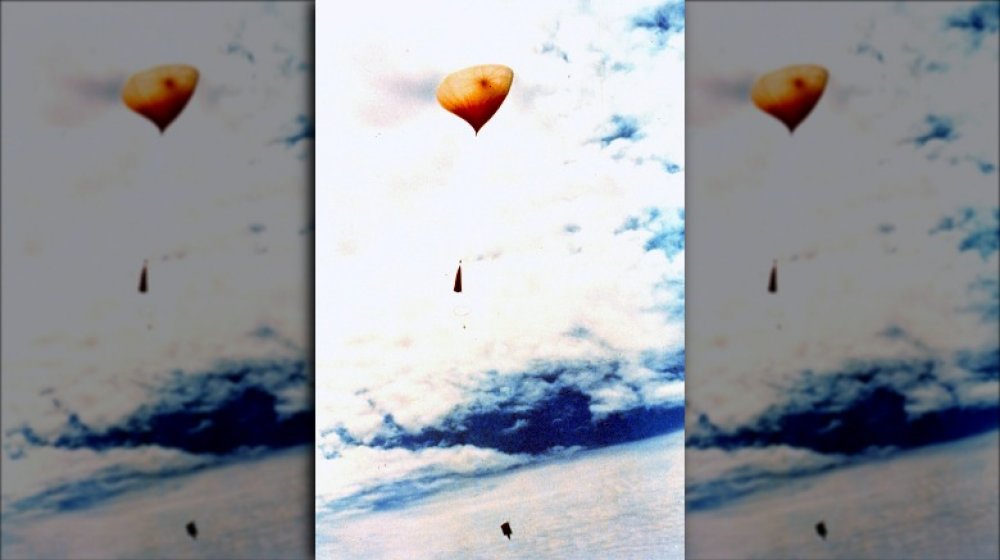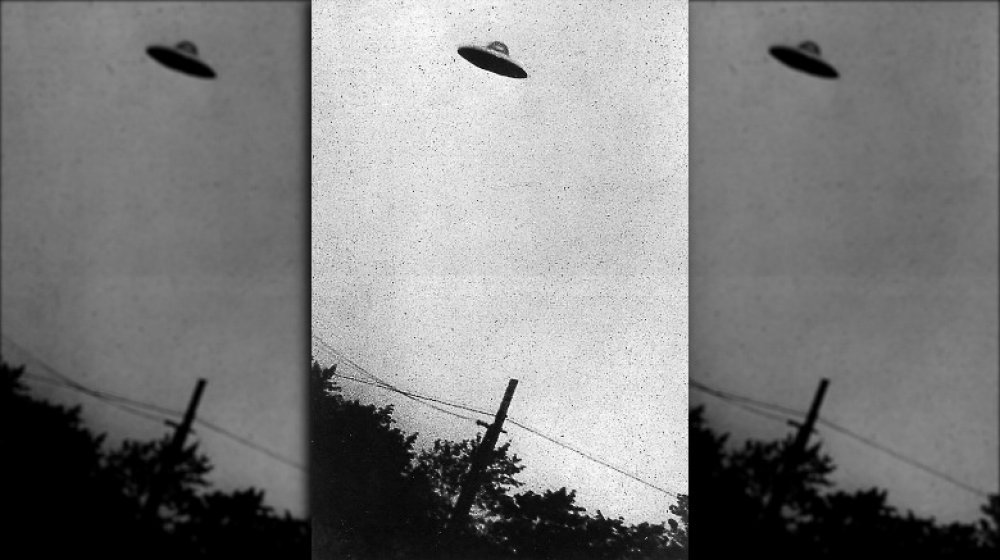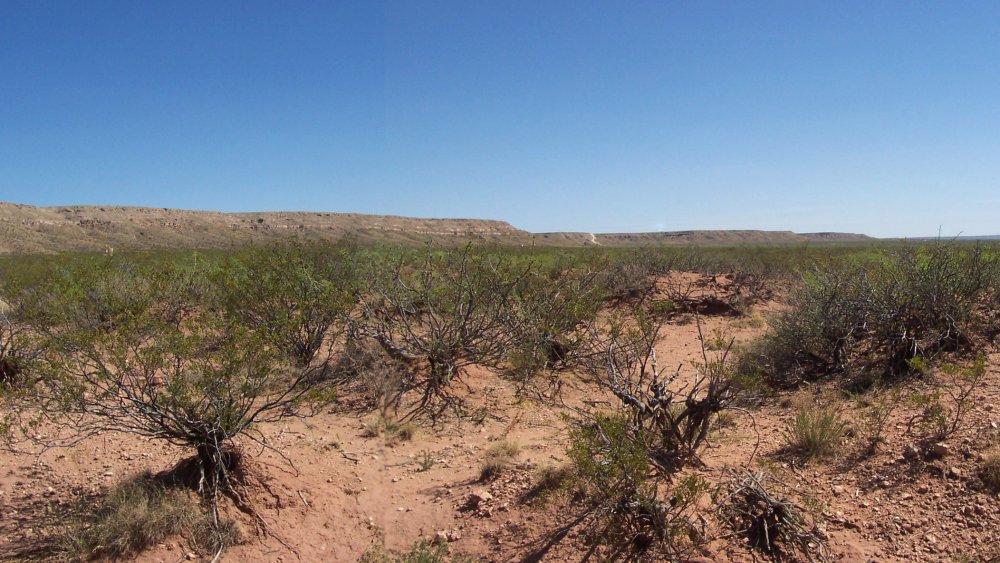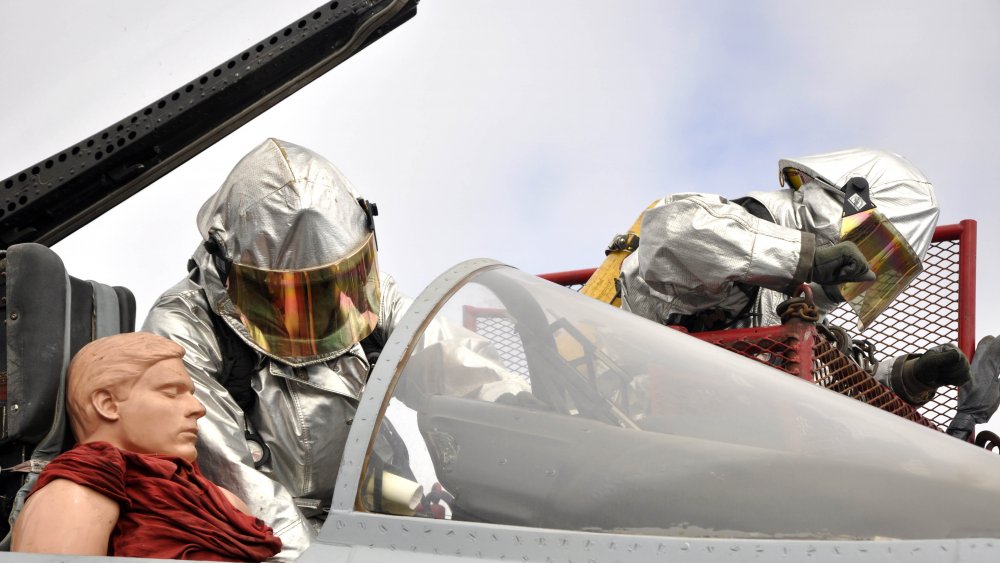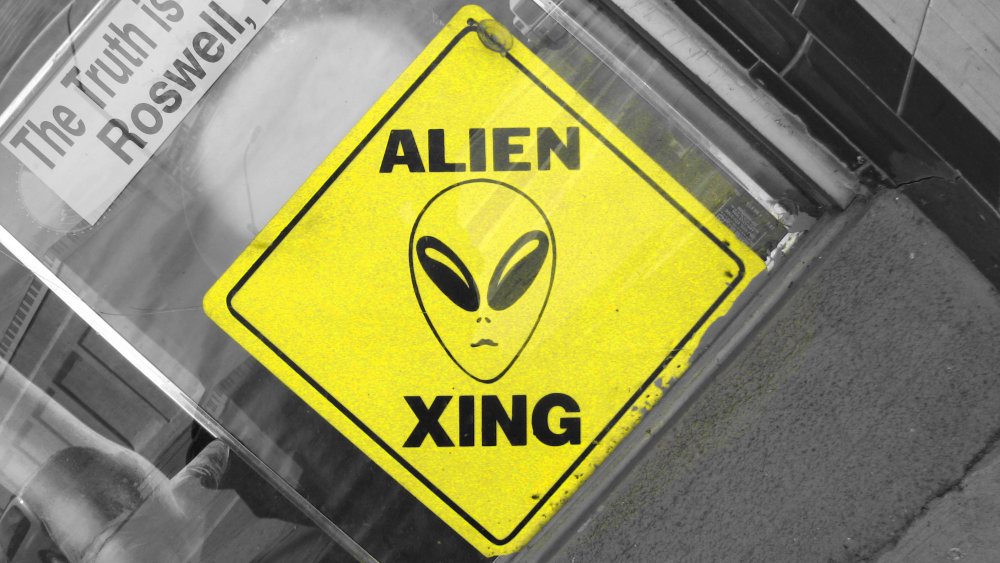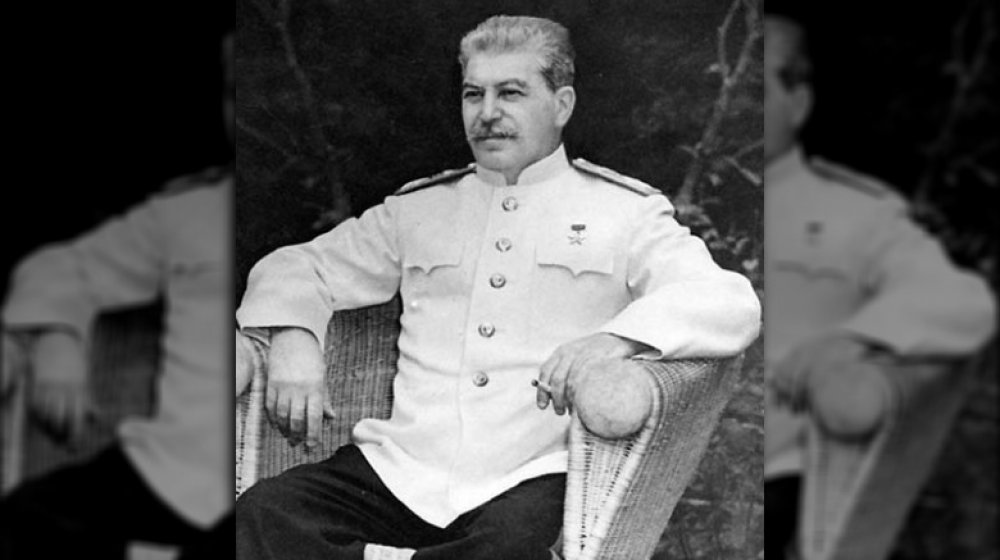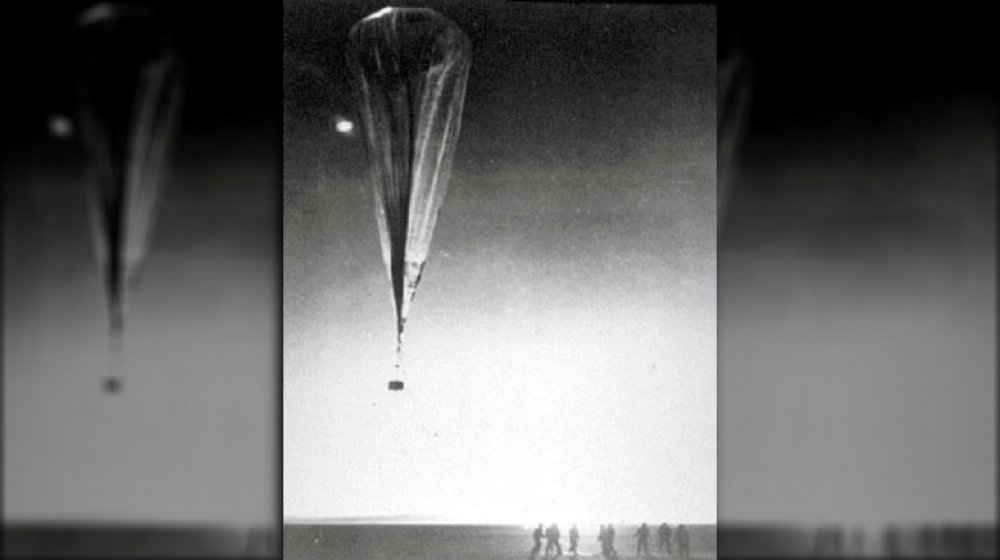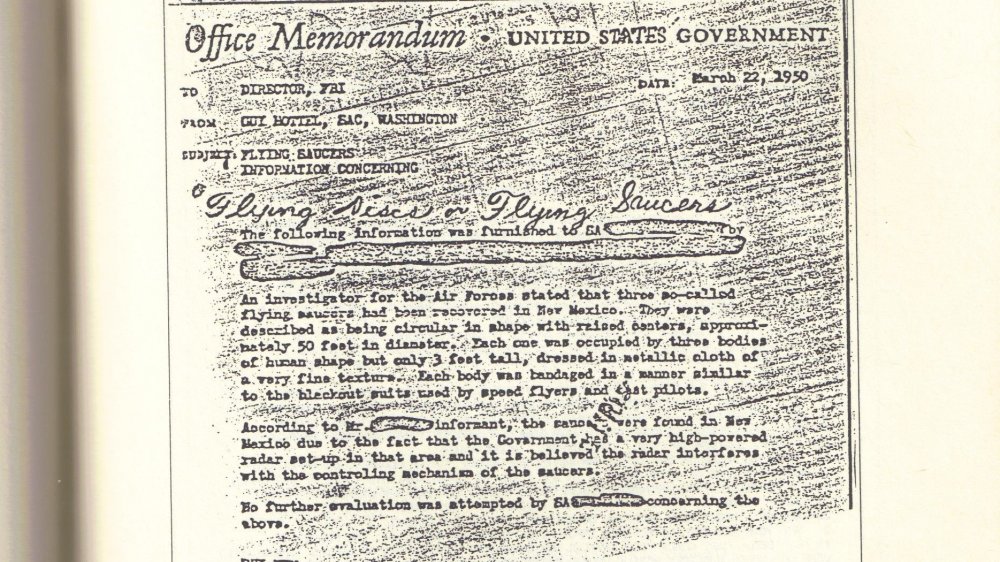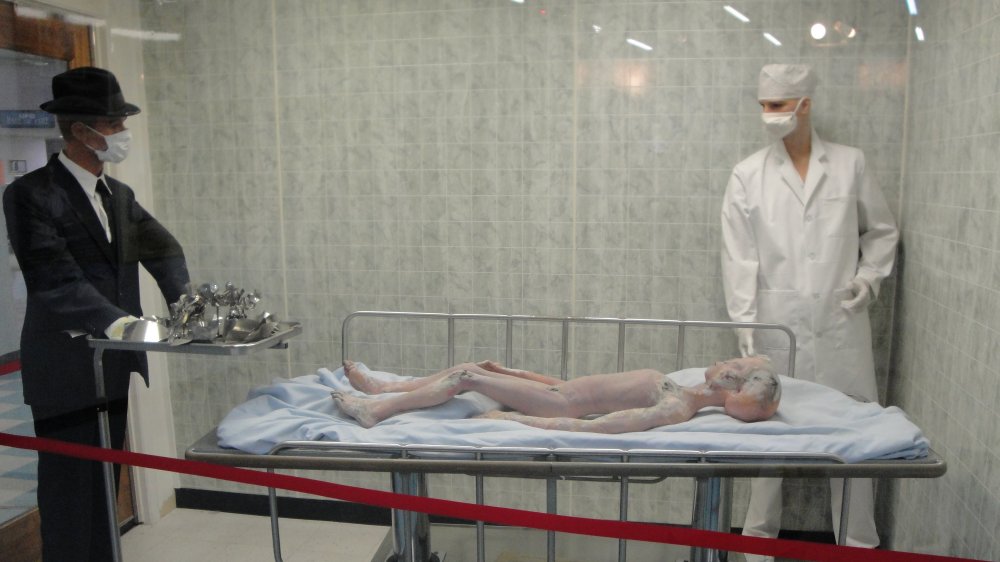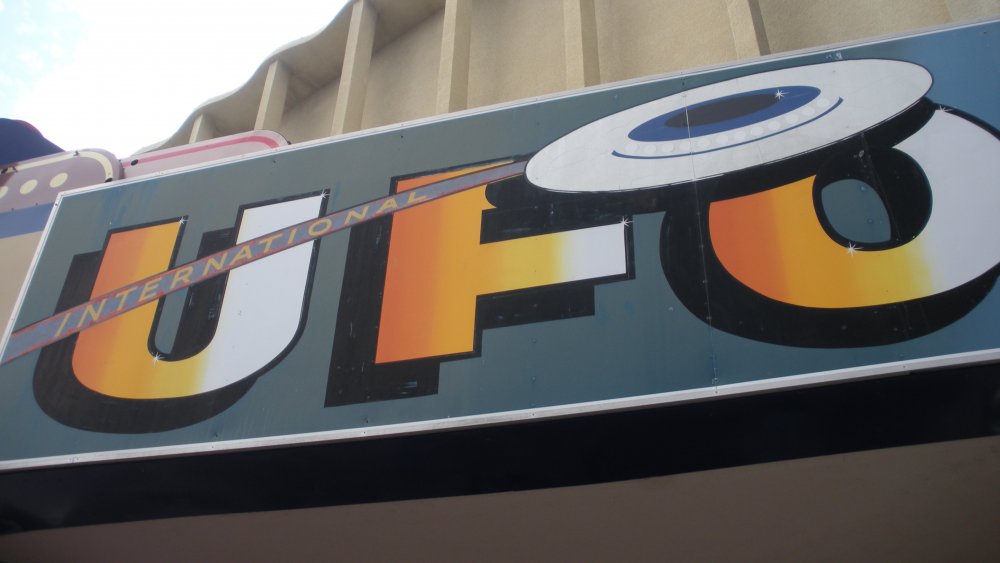Why You Rarely See The Roswell Incident In School History Books
In July 1947, something fell from the skies over southeastern New Mexico. It crashed into the desert near the town of Roswell, scattering bits of what looked like metal, wood, and pieces of rubber across the landscape. Rancher W.W. "Mac" Brazel was the first to happen upon the wreckage, the Smithsonian National Air and Space Museum reports. Brazel eventually reported his find to the sheriff in Roswell, who then told the military personnel at the Roswell Army Air Field. The Army hustled out to the desert, cleaned up the wreckage, and that was that.
Except, it wasn't. Soon after, the Army put out a press release claiming that it had cleaned up a "flying disk," which they later changed to a high-altitude weather balloon. Their subsequent caginess amid the increasing tension of the Cold War quickly gave rise to conspiracy theories. Why would the Army be so weird about a crashed weather balloon? Perhaps it was something far stranger. Could what was eventually called the "Roswell incident" in fact be evidence of humanity's contact with alien life?
The theories that followed the incident have made for plenty of entertaining stories with, unfortunately, little direct evidence. Despite some people's claims to the contrary, no one's produced clear, decisive evidence. No one's displayed the remains of an extraterrestrial craft or its otherworldly occupants. That uncertainty, coupled with some of the more colorful stories about the Roswell incident, has made the whole affair a complicated thing to put into your standard history textbook.
Few people agree about the facts of Roswell
In the summer of 1947, the Roswell Daily Record reported that the U.S. Army Air Forces had sent out a press release claiming that it had recovered a "flying disk" near Roswell, New Mexico.
These are about the only details agreed upon by practically everyone who's studied the incident. All of the other stories and explanations, from what crashed in the desert to what happened to the debris, has been up for debate ever since.
Eventually, per History, the USAAF would deny that the so-called "flying disc" was of alien origin. The Corsicana Daily Sun ran a photo of head intelligence officer Jesse Marcel with the debris, with a headline saying that the "Army Disk-ounts New Mexico Find as Weather Gear." They did more or less acknowledge that something had crashed into ranch land some 75 miles north of the town of Roswell. The recovered bits of whatever it had been were quickly taken away and hidden from the public, with little explanation offered up other than the claim that it had been only a weather balloon. In the absence of a good explanation or solid evidence, many began to wonder. Was it really an alien spacecraft? After all, hadn't people been sighting strange lights and odd-looking craft in the sky throughout the world? Or was it the result of a growing paranoia over international affairs, coupled with cultural interest in unidentified flying objects?
The U.S. government was pretty quiet about the Roswell incident
The military and government didn't want to disclose much information about what landed north of Roswell, New Mexico. Their close-lipped approach allowed conspiracies to flourish in the decades that followed the initial crash. Were they hiding incredible evidence of alien contact, or is there a more Earthly explanation?
According to Britannica, rancher Mac Brazel was the first known person to see the wreckage in June of 1947. As the government-produced book, The Roswell Report, says, Brazel reported that the debris included metallic foil, rubber-like material, tape, paper, and what seemed to be thin, light pieces of wood. Brazel indicated that he had come upon crashed government weather balloons on the ranch before, but that this looked very different from his earlier finds. He eventually reported this find to the Roswell sheriff, who in turn contacted the local Roswell Army Air Field. The RAAF then released the infamous press release claiming that they had recovered a "flying disc." Soon, they walked back their statement, saying instead that Army personnel had recovered the remains of a weather balloon, complete with a radar target.
For much of the following decades, as far as the government was concerned, that was that. Their input on the incident would be sparse indeed until the reveal of the anti-Soviet Project Mogul in 1994, The New York Times reports. In the absence of more information or even acknowledgment of the incident, conspiracies flourished.
The Roswell Incident is part of a complicated UFO craze
The Roswell incident happened at just the right time to add fuel to the growing UFO craze. Wired, like many other sources, pinpoints the beginning of the cultural interest in extraterrestrial visitors and strange objects in the sky to Kenneth Arnold, a pilot. Arnold had been flying solo to Yakima, Washington, when he saw nine aircraft. He claimed to have clocked them all moving in excess of 1,000 miles per hour, then practically impossible for any airplane or other craft known to our species. Once word of his sighting got out, it seemed as if everyone was seeing weird lights and craft flying around above them in what was later deemed a UFO "flap."
Often credited as a reliable witness, it was hard for many to dismiss Arnold's story, though many others ridiculed him anyway. According to The Guardian, the growing anxiety of the Cold War made people worldwide suspicious of strange things seen zooming through the sky. Anything seemed possible. The Roswell incident, situated as it was at the very beginning of the social phenomena, has since had many decades to grow more and more complicated in the minds of both skeptics and believers.
A military team sent to retrieve debris might have been mistaken for aliens
Decades after the Roswell incident sparked another story of UFOs, one scientist admitted that he may have been one of the "aliens" seen in the rural New Mexico desert. Yet, his explanation was altogether more worldly. He thought that he may have been mistakenly identified as an alien during the cleanup of another Project Mogul crash.
Florida Today reports that Walter Singlevich, who died in 1992, said that he was part of a crew sent to retrieve the remains of the balloon near Roswell. Singlevich and an associate donned hooded, silvery radiation suits that apparently shocked a nearby woman so badly that she fainted at the sight of them. After making sure that she was okay, the team left the unconscious woman alone and continued on their top-secret mission. They gathered up the debris, loaded it into their helicopter, and flew off.
The woman in Singlevich's story has never been identified. One can imagine that, after she woke, she made her way back to a nearby ranch house and shocked her friends and family with a story of mysterious figures who appeared out of a military helicopter or even an alien craft. Though this would have happened during the early 50s, it was close enough to Roswell that one wonders if it was eventually folded into the lore of the earlier crash.
Air Force dummy drops made things even more confusing
During the 1950s, the United States Air Force continued their work with high-altitude balloons. However, much of this work was still highly classified, thanks to the Cold War and escalating tensions with the Soviet Union and their allies. This secrecy may have protected national security, but it also served to increase suspicion from those who had decided that extraterrestrials were in the mix.
Some of the most suspicious-looking activities were so-called "dummy drops." According to History, these were experiments managed by the Air Force. Humanoid dummies made of aluminum and latex were dropped from high altitudes, ostensibly to study the effects and help human pilots survive similar falls.
As per Popular Science, these drops began in New Mexico in 1954. So, how could they have been tied to the 1947 Roswell incident? It's possible that witnesses to the drops, who would have had almost no idea what was going on, could have consolidated their memories over the years. The journal Nature Reviews Neuroscience states that human memory is notoriously unreliable and mutable, and it often becomes a story constructed by the person remembering, rather than a clear recollection of facts. For someone living near Roswell, perhaps in rural settings with slow access to news sources, seeing dummy recovery could have looked weird indeed. Imagine how cagey military personnel rushing in, gathering up the mess, and then leaving without speaking to anyone, would have only made it look all the more suspicious.
Some mysterious slides deepened the mystery of aliens and Roswell
After more than 70 years since the incident, the story of Roswell has remained compelling and mysterious. While no concrete evidence of alien life was ever found in connection with the 1947 crash, others counter that this is simply because the U.S. government or some other entity has enacted a huge cover-up. Then, in 2012, someone thought they might have uncovered a smoking gun in a pile of old slide photos.
According to The Guardian, the slides in question were supposedly uncovered in 1998, but it wasn't until 2012 when videographer Adam Dew went through the lot with former business partner Joseph Beason. Amongst the midcentury pictures of President Eisenhower and Clark Gable, they found something shocking: an image of a body.
Said body appeared to have been mummified, which wasn't shocking in itself. But what about the huge head? The tiny arms? Could this be proof that aliens crashed at Roswell, where their remains were recovered and then put into government hands?
An investigation revealed that the slides were genuine and hadn't been altered. Researchers displayed the image at an event in Mexico City. Then, as more people got their hands on the image, it became clear that this was no alien. Instead, evidence points to the slide showing a museum exhibit featuring the remains of a two-year-old Native American boy. Investigators involved with the project were humiliated and even accused of altering the image.
People kept adding to the Roswell story long after the incident
As public interest in UFOs grew, more and more details about the Roswell incident popped up. According to The New York Times, Stanton Friedman, a nuclear physicist turned UFO investigator, got wind of the story and became the first civilian investigator in the matter. In 1992, he published his findings in Crash at Corona, further generating interest and speculation about the Roswell incident. Friedman, whose academic and professional background lent credibility to his claims, claimed that the U.S. government had undertaken a "cosmic Watergate" to conceal the truth of alien contact.
That sustained attention has generated some versions of events that cause some skeptics to doubt the whole thing. Some supposed witnesses said they had seen two ships crash in the desert, with alien remains scattered amongst the debris, Smithsonian Magazine reports. Southern Methodist University notes that the story became increasingly complex and dramatic over time, helped along by a bevy of reports, books, and word of mouth. For instance, rancher Mac Brazel's account of finding the debris included a description of the material, which included what appeared to be Scotch tape. He also described a kind of decorative tape which initially sounded like it was covered in images of flowers. As the years have gone on, however, the flowers seem to have turned into complex hieroglyphics in the collective imagining of the incident, then taken as evidence of government symbols or even an unknown alien language.
Some argued that the Roswell flying saucer came from Russia
One of the wildest and most textbook-inappropriate theories claims focuses on the United States' long-simmering Cold War nemesis, the Soviet Union. Despite the absence of hard evidence, some have since claimed that none other than Joseph Stalin, leader of the Soviet Union, was behind the crash at Roswell.
According to NBC News, the highly speculative theory maintains that the Soviets used Nazi scientists to develop disc-shaped aircraft that could evade radar detection. Scared by U.S. development of atomic weapons, they released smaller craft over New Mexico in an attempt to intimidate their rivals and plant seeds of fear nationwide.
The story, which journalist Annie Jacobsen claims is based on a single, unidentified source, gets wilder from there. As Mother Jones reports, Jacobsen's 2011 book, Area 51, says that the downed craft was inhabited. Only, it wasn't aliens inside, but deformed adolescents who were modified by none other than Nazi doctor Josef Mengele. The idea, apparently, was that people would be so freaked out by mangled Soviet children climbing out of a flying disc that Americans would panic en masse. U.S. radar systems would be overwhelmed by false sightings, leaving an opening for Soviets to come in and attack their enemy, presumably in yet more flying saucers.
The government later admitted the Roswell crash was part of a mysterious anti-Soviet project
It took more than 45 years for the U.S. government to offer up a more substantive answer to what, exactly, crashed in the desert north of Roswell in 1947. However, as interest in UFOs and conspiracy theories had only grown since then, not everyone was satisfied with the explanation offered.
According to a report issued by the National Security Agency in 1994, the bits of metal, wood, and rubber that rancher Mac Brazel found was part of something called "Project Mogul." This was no mere weather balloon. Instead, Project Mogul was a top-secret undertaking meant to combat what the U.S. government believed was a dangerous Soviet threat. The high-altitude balloons, constructed out of metallic polyethylene fabric, were equipped with sensors that could detect radioactivity from Soviet weapons tests.
During the Cold War, much of the planet was preoccupied with who had nuclear capability, to what extent they had it, and how they were planning to use this potentially deadly ability. However, no one in the U.S. government wanted information like this to get into Soviet hands, hence the secrecy.
This explanation did not satisfy everyone, The New York Times reports. Though the program was closed in 1950, bits of wayward balloon assemblies could still be found in the American Southwest. A close-lipped government that sometimes snatched up the debris with little explanation given to bystanders did not inspire confidence in dedicated conspiracy theorists.
A mysterious memo still excites Roswell believers
In a news photograph dated July 8, 1947, the University of Texas says, Brigadier General Roger Ramey is seen holding what appears to be a memo in one hand. Though it's hardly a high resolution photograph and Ramey has turned the paper slightly away from the camera, analysts have spent years trying to decipher its contents.
No one's produced definitive results, but this piece of paper has produced plenty of arguments and confusion anyway. According to the Journal of Scientific Exploration, different teams have produced different interpretations of what's in the memo, probably because of preexisting bias towards one conclusion or another. Some phrases are consistent amongst different analyses, but none of them have produced a bombshell. It's also important to note that, if the contents of the Ramey memo were classified, there would be a visible stamp that we should see even in this photo. No one's even sure if this memo would refer to the Roswell incident in the first place.
The Alien Autopsy film muddied the waters
In 1995, Time reports, Fox television broadcast a special titled Alien Autopsy: Fact or Fiction. The program included footage from a 17-minute black and white film that allegedly documented the autopsy of an alien corpse. The remains, it was said, had been recovered from the Roswell crash and would have been examined shortly thereafter. If true, the footage would prove to be an absolute bombshell of a reveal, with a true-blue extraterrestrial body right there on the slab. But, was it true?
Almost immediately after its release, the film drew the ire of skeptics. The Skeptical Inquirer published a surgeon's estimation of the film, which he concluded was a pretty poor fake of a standard autopsy, even of one from 1947. It was also incredibly suspicious that the film routinely went in and out of focus, almost as if the camera operator was trying to conceal evidence of fakery.
Ray Santilli, the entrepreneur who released the film, said he had received it from a retired Army photographer who wished to remain anonymous. Yet, as The Fortean Times reports, the increased scrutiny soon revealed a major issue: the film was faked. Santilli later claimed that he had recreated scenes he viewed on the genuine but crumbling film, though that hardly inspired confidence amongst anyone but the most dedicated conspiracy theorists.
Roswell, New Mexico still benefits from the alien craze
Many of the people living in and around the city of Roswell seem plenty happy to encourage the idea that aliens crash-landed nearby in 1947. That's because the Roswell incident is still great for tourism, even seven decades later.
According to Imagining the American West Through Film and Tourism, Roswell has benefited mightily from the incident and the subsequent UFO and conspiracy theory craze. It's got new construction, busy hotels, and, of course, the UFO Museum and Research Center at the heart of town.
The city also hosts the annual UFO Festival, which attracts large crowds to the area. The New York Times reports that the event includes lectures, a parade, costumes everywhere, and, of course, plenty of gift shops packed with alien-themed souvenirs. In recent years, KRQE says that the event has become so successful that the City of Roswell is looking for an events firm to improve and organize future festivals, which they hope will be even larger and more well-attended than past festivals. Perhaps, for many people who believe that the 1947 incident has brought some degree of fame and fortune to what had been a backwater desert town, it's better if some of the questions of Roswell remain unanswered.
